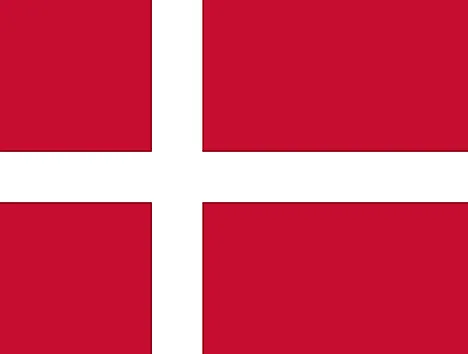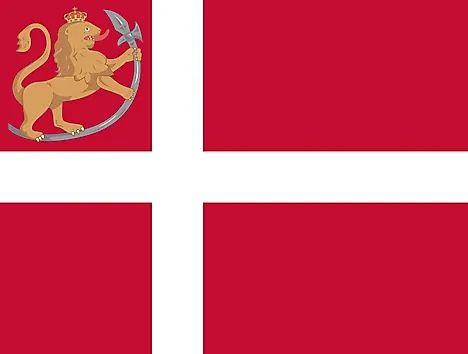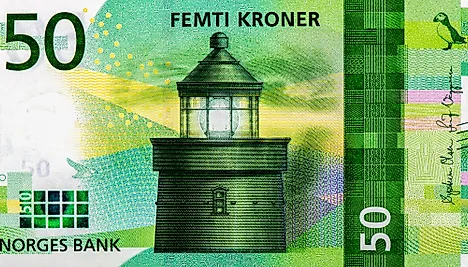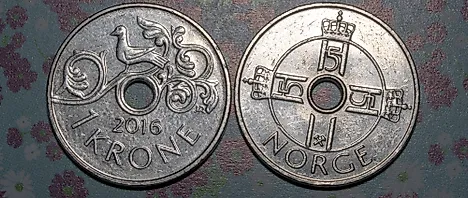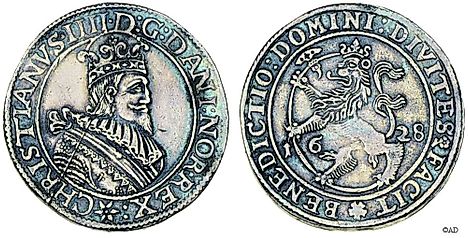Flags, Symbols, & Currencies of Norway
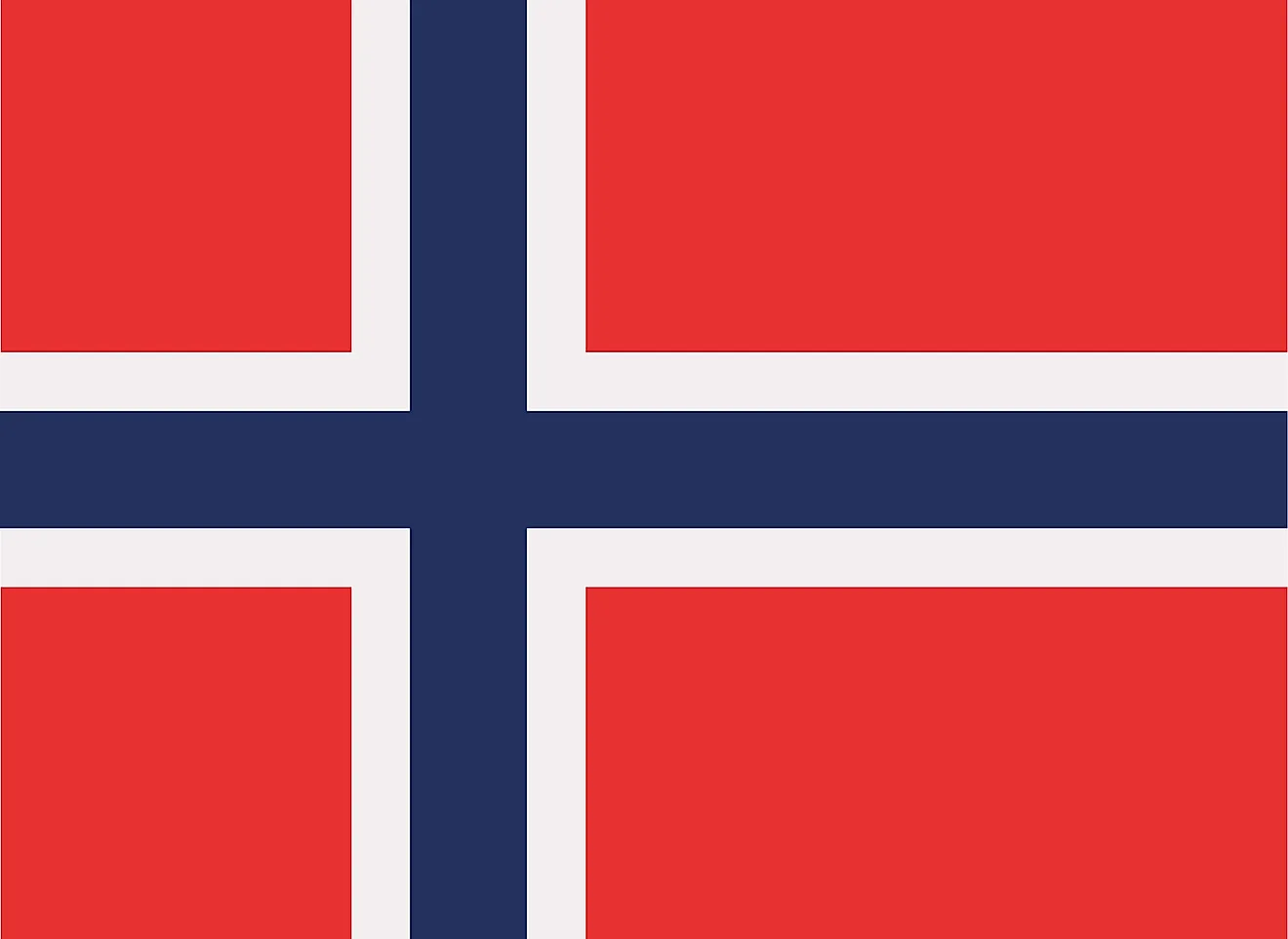
The flag of Norway was adopted in the 19th century, on July 17, 1821. It is made of a red background and has a blue cross superimposed on a white cross so that the white cross outlines the blue color (the Scandinavian cross). The flag has a proportion of 11:8 for width to the length. The colors of the flag of Norway are believed to have been influenced by the flags of the US, Britain, and France with the colors associated with independence and liberty. The cross is common among the Scandinavian countries and represents the link with other Scandinavian countries.
Symbolism
Like most flags around the world, each color and symbol on the Norwegian flag bears meaning to the people. The Nordic cross represents Christianity which is the man religion in the whole region. The white and red colors represented the union that Norway had with Denmark. The Blue color that makes up the cross represents Norway's union with Sweden before they gained autonomy, a symbolism that expresses their love for peace and amicable relations with each other. The combination of the three colors was something they borrowed from the France where the colors represent liberty
A Brief History Of The Flag
The flag currently in use was adopted in 1821 and was designed by Fredrik Meltzer, who was a Danish member of parliament. The Norwegian flag owes its origins to the old monarchy that used to have their flag. However, by the 1500s ships from the region started flying the flag on the masts as a way of identifying themselves, back then the flag was red with a silver halberd and a golden lion as the emblems. For a period that lasted from the 16th century to circa1814, Norway used the same flag as Denmark owing to the union that the two countries had at the time. When Norway finally became a separate state from its Scandinavian neighbors in 1821, the current flag became the official state flag.
Flag Traditions
The flag is hoisted during festivals, and special occasions and the affair is often accompanied by the singing of the national anthem or a bugle call. The Norwegian army has a particular bugle call they use for lowering or hoisting the flag called flaggappell which translates to “attention to the flag.” After lowering, the flag is rolled up into a cylindrical shape and tied up carefully to ensure creases do not form.
Symbols of Norway
National Coat of Arms of Norway

The National Coat of Arms dates from the Middle Ages and features an upright, yellow crowned lion rampant, holding a white and yellow axe on a red shield. Above the shield is a crown with a cross. It's one of the oldest in all of Europe and originated as a personal coat of arms for the royal family. After slight adjustments over time, the current version shown was approved by the King of Norway on May 20, 1992.
National Anthem
- Anthem Title:, Ja, vi elsker dette landet (Yes, we love this country)
- Composer: Rikard Nordraak
- Lyricist: Bjørnstjerne Bjørnson
- Year of Completion: 1864
- Date of First Performance: May 17th, 1864
The currently recognized national anthem of Norway is Ja, vi elsker dette landet (Yes, we love this country), also called "Song for Norway". The song has held the status of being Norway's national anthem since the earlier parts of the 20th century. No official national anthems are recognized in Norway, but multiple anthems have been publicly recognized for a span of almost 200 years.
Bjørnstierne Bjørnson wrote the lyrics during the period of 1859 up to 1868. Bjørnson's first cousin, Rikard Nordraak, was responsible for the melodic composition of the song, which he created from 1863 to 1864. Bjørnson originally included lyrics that hailed King Charles IV. However, due to international conflicts in 1864, Bjørnson decided to remove all lyrics that paid tribute to the king. The first public performance of the song was held on May 17th, 1864, during the celebration of the 50th anniversary of Norway's constitution. The first and last two stanzes of the songs are the only ones that are commonly sung.
Sønner ay Norge and Norges Skaal were the most widely recognized national anthems of Norway until the middle part of the 1860s. However, until the beginning of the 20th century, both songs were sung alongside each other, with official events using Sønner av Norge.
In 2011, the media started dubbing Ole Paus' Mitt lille land as the "new" national anthem of the country, with the song being played countless of times after the 2011 Norway attacks occurred. Despite what the media has portrayed, Ja, vi elsker dette landet still remains as the most widely recognized national anthem by the Norwegian people. The song is also met with controversy due to the fact that it was used as an anthem by Nazi collaborators for propaganda. Over time, Germans banned the use of Ja, vi elsker dette landet.
Ja, vi elsker dette landet
Ja, vi elsker dette landet,
som det stiger frem,
furet, værbitt over vannet,
med de tusen hjem, —
elsker, elsker det og tenker
på vår far og mor
og den saganatt som senker
drømmer på vår jord.
Og den saganatt som senker,
senker drømmer på vår jord.
Norske mann i hus og hytte,
takk din store Gud!
Landet ville han beskytte,
skjønt det mørkt så ut.
Alt, hva fedrene har kjempet,
mødrene har grett,
har den Herre stille lempet,
så vi vant vår rett.
Ja, vi elsker dette landet,
som det stiger frem,
furet, værbitt over vannet,
med de tusen hjem.
Og som fedres kamp har hevet
det av nød til seir,
også vi, når det blir krevet,
for dets fred slår leir.
Yes, we love this country
Yes, we love this country
as it rises forth,
rugged, weathered, above the sea,
with the thousands of homes.
Love, love it and think
of our father and mother
and the saga night that sends
dreams to our earth.
and the saga night that sends
dreams to our earth.
Norwegian man in house and cabin,
thank your great God!
The country he wanted to protect,
although things looked dark.
All the fights fathers have fought,
and the mothers have wept,
the Lord has quietly moved
so we won our rights.
Yes, we love this country
as it rises forth,
rugged, weathered, above the sea,
with those thousand homes.
And as the fathers' struggle has raised
it from need to victory,
even we, when it is demanded,
for its peace will encamp (for defence).
The Currency of Norway is the Norwegian krone
The official currency of Norway and its dependent territories is the Norwegian krone (plural kroner), which uses the sign kr and the code NOK. The name of the currency basically translates into English as “crown.” The currency is subdivided into 100 øre, which have existed solely on an electronic basis since 2012. As of April 2010, the krone was ranked as the 13th most traded currency in the world. Its ranking had dropped down three positions from 2007.
Coins and Banknotes
Norwegian krone coins were introduced in 1875 in denominations of 10 and 50 øre and 1 and 10 kroner. Between 1875 to 1878, coins were introduced in the denominations of 1, 2, 5, 10, 25, and 50 øre and 1, 2, and 10 kroner. The coins that are currently legal tender are 1, 5, 10, 20 kr.
Kroner banknotes were first introduced in 1877 in the denominations of 5, 10, 50, 100, 500 and 1000 kroner. 1-kroner notes were introduced 1917, followed by 2-kroner note the following year. The current banknotes in circulation are in the denominations of 50, 100, 200, 500, 1000 kr.
Exchange Rates of the Norwegian Krone
Compared to the other currencies around the world, the value of the Norwegian krone tends to vary rather significantly on a year to year basis. This is associated with the fluctuations in interest rates and oil prices. The Norwegian krone reached record levels in 2002 against the United States dollar and the euro. For example, on January 2, 200, 100 kroner was worth 11.14 US dollars (8.98 NOK = 1 USD), and by July of the same year, 100 kroner were equal to 13.7 US dollars (7.36 NOK = 1 USD). The change is explained by high oil prices and and a 7 percent increase in the interest rate on July 4, 2002. At that time, Norway was considered the world's third largest oil exporter.
In early 2008, the US dollar started depreciating against all other major currencies across the world, which made the Norwegian krone stronger than in comparison to the USD. At this point, 1 USD became equal to 5 NOK. However, the USD recovered its worth by October 2008, and became worth 7 NOK. The NOK once again gained value in 2009, and 1 USD became equal to 5.8 NOK. Since then, the USD has recovered its value and has been standing at 8.5 NOK since mid 2016.
History of Currencies of Norway
The krone was initially introduced back in 1875, and replaced the Norwegian speciedaler, and it was valued at 1 speciedaler being equal to 4 kroner. This paved the way for Norway to become part of the Scandinavian Monetary Union that was created in 1873. The union was dissolved in 1914, after which the former member countries chose to keep the names of their respective currencies. These included Sweden, Norway and Denmark, and since then, all these countries have had their separate currencies.
Between 1916 and 1920, and again in 1928, the krone held a gold standard of 1 kilogram of pure gold = 2,480 kroner. However, the standard was brought to a permanent ban in 1931, and the krone was instead pegged to the British pound, at a rate of 19.9 kroner to 1 British pound. In 1939, the krone was temporarily pegged to the US dollar at a rate of 4.4 kroner $1 US dollar.
